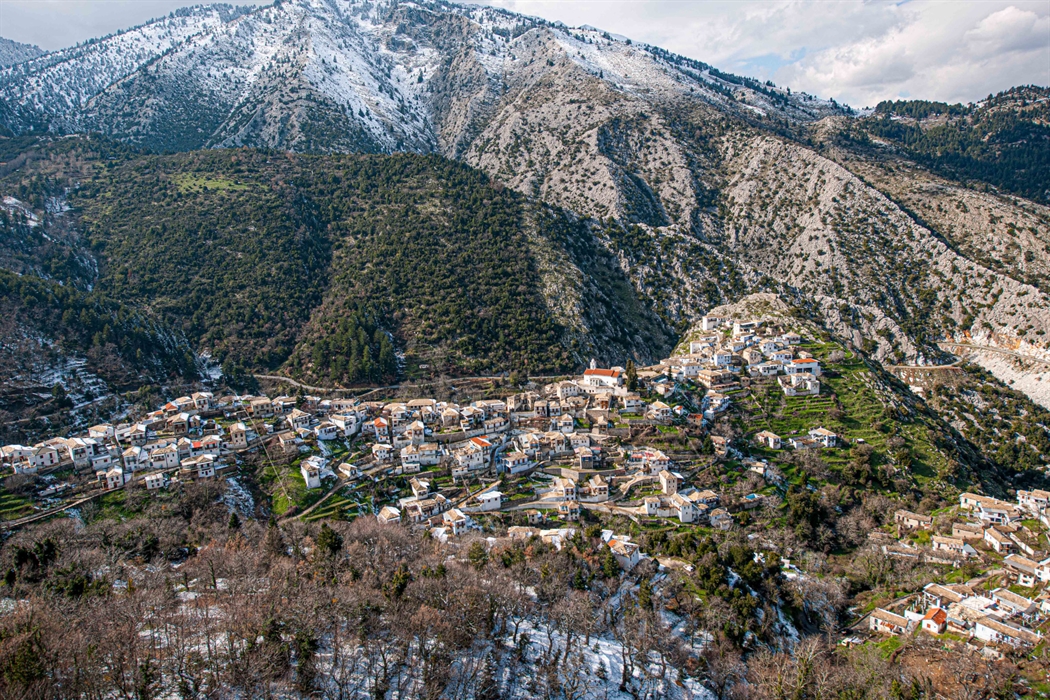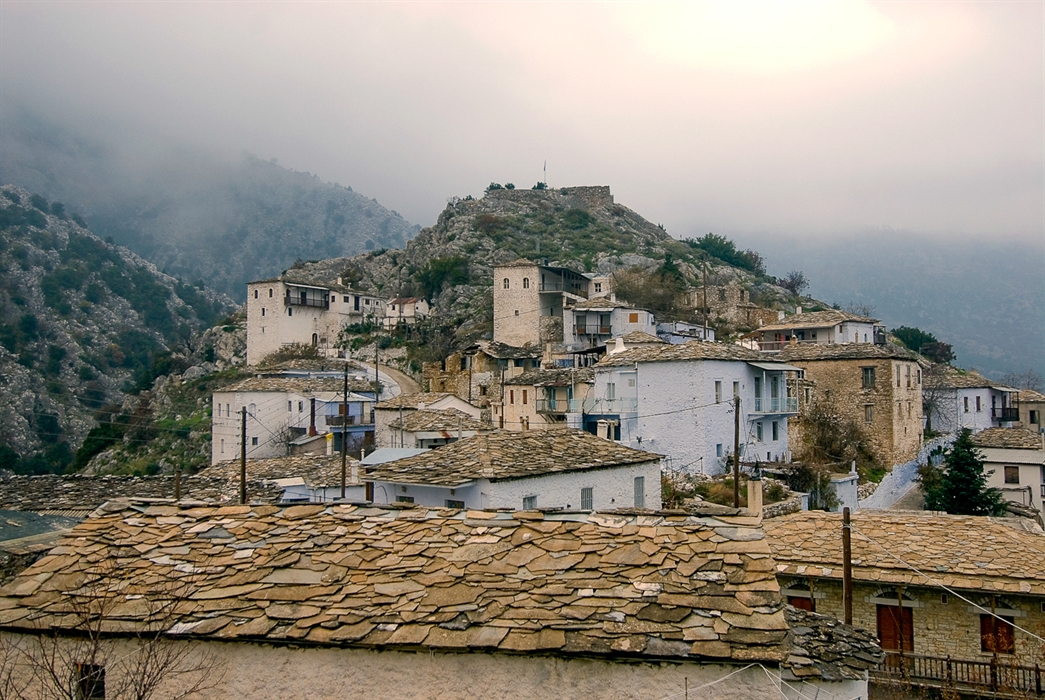Kastanitsa
The first thing that will strike you is the village’s setting on the slopes of Mount Parnon, surrounded by green ravines with chestnuts, firs and plane trees. Unlike most other mountain villages, many of the stone-built houses here are lime washed which gives the village a very different feel -almost as if you have wandered into an island village.
Kastanitsa is a bit special. Firstly, unlike most other mountain villages, many of the stone-built houses here are lime washed which gives the village a very different feel -almost as if you have wandered into an island village. On top of that, the traditional three-storey “tower houses” which jostle for space on the hillside seem to look out over the countryside with a benevolent, if slightly surprised, expression thanks to the way their windows are positioned like two eyes and a mouth! And thirdly, many people think that Kastanitsa is one of the most beautiful mountain villages in Greece. So why not take a trip through the narrow country roads to Kastanitsa and see if you agree?
The first thing that will strike you is the village’s setting on the slopes of Mount Parnon, surrounded by green ravines with chestnuts, firs and plane trees. In fact, the village’s name comes from the Greek kastania – chestnut tree. It is an old village, supposedly the oldest in the Tsakionia, and many of the houses are 300 years old. As you stroll round the (mostly car-free) cobbled streets and steps you’ll get a better look at the three-storey, old tower houses with their ash green slate roofs, wooden balconies and small windows. They are scattered all over the village, but the Pyrgos district has some of the best examples. As you explore the village you’ll be able to enjoy a great view over the Argolic gulf from certain points, including from the village square.
Another thing to look out for, above the old primary school, is the impressive Church of the Transfiguration of the Saviour which dates from 1780. If you go inside the church, don’t miss the elaborate Russian iconostasis made in Odessa in 1818 - a gift from Catherine the Great to an eminent citizen of Odessa who came from the village.
Sometimes it seems as if every self-respecting mountain village has a ruined castle - and Kastanitsa is no exception. High above the village, to the north and on a suitably impressive rock outcrop you will see the ruins of the Kapsampeli tower. The climb up is a bit of a scramble, but worth it for the amazing view. As far as we know the castle was built in the 14th century by the Byzantines so they could control the road from Argolis to the Laconian plain. Later on, during Ottoman rule, the villagers used to flee to the castle to protect themselves from the Turks. We know it was over 8 m high and had two floors and battlements, but unfortunately it was destroyed in 1945 during the Civil War.
Finally, if you are wondering why so many of the buildings are whitewashed (or more correctly speaking limewashed), the answer lies in the village’s past. In the 1950s and 60s Kastanitsa was famous for producing limewash. At that time, there were 15 furnaces in the village, and up to 200 people worked 15-20 hours a day in the industry. Lime was produced in a traditional way which was both time-consuming and difficult, with the furnaces burning for up to 120 hours. There were also water mills outside the village, but today only the ruins of one, which was closed in 1970, remain.
There are several chapels in and around the village, the oldest of which is that of Agios Panteleimon, which you can reach after a walk through a beautiful forest of chestnut trees. It was originally the two-story main church of the monastery of Agios Nikolaos Kontolinas, which was built at the beginning of the 16th century and was burned down by the Turks in 1826.
Walks. Starting from the square of Kastanitsa, you can take an easy circular route through the wonderful forest landscape to see the Panayia Barkos church and the spring of Mana. Another suggestion is to follow the old Agios Dimitrios path to reach the chapel of Panagia Bistolena.
There is also an excellent 7.8 km signposted trail from Kastanitsa to Prastos that starts from Ai Giorgi. It runs along the eastern slopes of Mount Parnon and was the old road between the two villages. You will pass through forests with chestnuts, cedars and plane trees and you see the Mazia river and pass by ruined water mills and old chapels and farmhouses.
The chestnut forests
The chestnut tree forests in the Mount Parnon area cover approximately 21,000 acres. In and around Kastanitsa there are many large, productive chestnut trees - even if production is now less than it once was. Since 1983, every last weekend of October a chestnut festival has been held in the village. If you happen to be here for the festival you will find stalls with products and treats (chestnuts cooked in every way you can imagine - baked, boiled, in conserves, etc.), and you can go on a guided tour of the events. The festival also includes music, dancing, a cooking competition and the 'kastanodori' which is a local version of the egg and spoon race- you guessed it, the chestnut and spoon race!
Platanos and the waterfalls of Lepida
Platanos is another beautiful traditional village in the area which is well worth a visit. It is the starting point for a lovely hiking route to the upper part of the Vrasiatis gorge and the idyllic Lepida waterfalls. The waterfalls are 70 m high, although they often dry out in the summer. This is a short 30 minute walk and is suitable for everyone. The only thing to watch out for is to avoid days with rain or snow because the rocks become very slippery.
The path starts about 2 km north of Platanos.
Did you know that
Kastanitsa is 72 km away from Tripolis.
The village has traditional guesthouses, cafés and tavernas. The local specialty is - unsurprisingly - pork with chestnuts.
The Tsakonian dialect is still spoken in the village.
Location
Find the destination on the interactive map below.
Σχετικό περιεχόμενο χρηστών (UGC)
Ενημερωθείτε για ενδιαφέροντα θέματα γύρω από τον προορισμό μέσα από το περιεχόμενο των χρηστών μας
Discover 7 hidden gems of the Peloponnese
Many of you may have already visited some of the most renowned attractions…
TOP 10 archaeological museums in the Peloponnese
Olympia, Mycenae, Epidaurus, Diros Cave, Ancient Corinth, Messene and…
TOP 10 Castles in the Peloponnese
Castles galore! Mystras, Monemvasia, Palamidi, Methoni, Koroni,…
Newsletters
- About us
- FAQ's
- Map
- Tourism information centers
- Disclaimer
- Sitemap
- Our brand
- Media roum
- Adding your bussiness
- Corporate
- MICE

Peloponnese. Greece beyond the obvious





Design and creation from Cosmote
Marinas and Moorings
Diving centers
Get inspired
- Media gallery
- Blog
- The Peloponnese in the media
- Your feedback
- Users' general content
- Users' local products
- Users' events content
- Ask a local
More
- Accommodation
- Travel agencies
- Restaurants
- Services
- Destinations Map
- Weather
- Public transport
- Events
- Frequently asked questions
- Useful phones
- B2B
- Destination Data
- Contact


